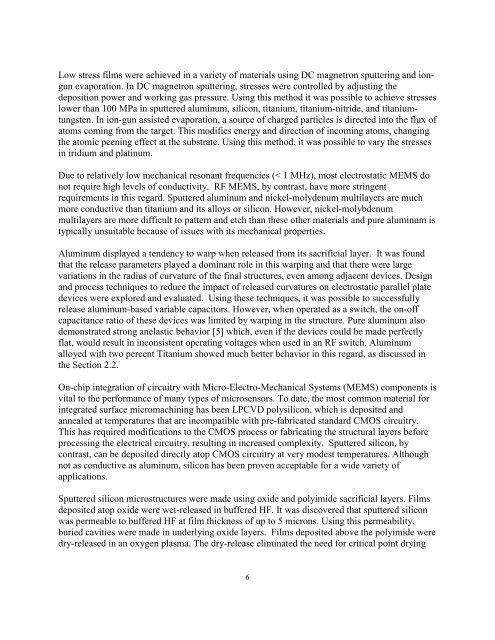Advanced CAD System for Electromagnetic MEMS Interactive Analysis
Advanced CAD System for Electromagnetic MEMS Interactive Analysis
Advanced CAD System for Electromagnetic MEMS Interactive Analysis
Create successful ePaper yourself
Turn your PDF publications into a flip-book with our unique Google optimized e-Paper software.
Low stress films were achieved in a variety of materials using DC magnetron sputtering and iongun<br />
evaporation. In DC magnetron sputtering, stresses were controlled by adjusting the<br />
deposition power and working gas pressure. Using this method it was possible to achieve stresses<br />
lower than 100 MPa in sputtered aluminum, silicon, titanium, titanium-nitride, and titaniumtungsten.<br />
In ion-gun assisted evaporation, a source of charged particles is directed into the flux of<br />
atoms coming from the target. This modifies energy and direction of incoming atoms, changing<br />
the atomic peening effect at the substrate. Using this method, it was possible to vary the stresses<br />
in iridium and platinum.<br />
Due to relatively low mechanical resonant frequencies (< 1 MHz), most electrostatic <strong>MEMS</strong> do<br />
not require high levels of conductivity. RF <strong>MEMS</strong>, by contrast, have more stringent<br />
requirements in this regard. Sputtered aluminum and nickel-molydenum multilayers are much<br />
more conductive than titanium and its alloys or silicon. However, nickel-molybdenum<br />
multilayers are more difficult to pattern and etch than these other materials and pure aluminum is<br />
typically unsuitable because of issues with its mechanical properties.<br />
Aluminum displayed a tendency to warp when released from its sacrificial layer. It was found<br />
that the release parameters played a dominant role in this warping and that there were large<br />
variations in the radius of curvature of the final structures, even among adjacent devices. Design<br />
and process techniques to reduce the impact of released curvatures on electrostatic parallel plate<br />
devices were explored and evaluated. Using these techniques, it was possible to successfully<br />
release aluminum-based variable capacitors. However, when operated as a switch, the on-off<br />
capacitance ratio of these devices was limited by warping in the structure. Pure aluminum also<br />
demonstrated strong anelastic behavior [5] which, even if the devices could be made perfectly<br />
flat, would result in inconsistent operating voltages when used in an RF switch. Aluminum<br />
alloyed with two percent Titanium showed much better behavior in this regard, as discussed in<br />
the Section 2.2.<br />
On-chip integration of circuitry with Micro-Electro-Mechanical <strong>System</strong>s (<strong>MEMS</strong>) components is<br />
vital to the per<strong>for</strong>mance of many types of microsensors. To date, the most common material <strong>for</strong><br />
integrated surface micromachining has been LPCVD polysilicon, which is deposited and<br />
annealed at temperatures that are incompatible with pre-fabricated standard CMOS circuitry.<br />
This has required modifications to the CMOS process or fabricating the structural layers be<strong>for</strong>e<br />
processing the electrical circuitry, resulting in increased complexity. Sputtered silicon, by<br />
contrast, can be deposited directly atop CMOS circuitry at very modest temperatures. Although<br />
not as conductive as aluminum, silicon has been proven acceptable <strong>for</strong> a wide variety of<br />
applications.<br />
Sputtered silicon microstructures were made using oxide and polyimide sacrificial layers. Films<br />
deposited atop oxide were wet-released in buffered HF. It was discovered that sputtered silicon<br />
was permeable to buffered HF at film thickness of up to 5 microns. Using this permeability,<br />
buried cavities were made in underlying oxide layers. Films deposited above the polyimide were<br />
dry-released in an oxygen plasma. The dry-release eliminated the need <strong>for</strong> critical point drying<br />
6
















